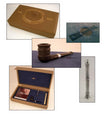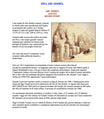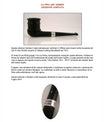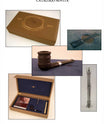Dunhill ABU SIMBEL PIPE LIMITED EDITION n. 46 out of 100 specimens
Regular price
€4.350,00
Sale
ABU SIMBEL AND HIS REDISCOVERY
The two temples of Abu Simbel were built in Nubia in the southern part of Egypt near the Sudanese border during the reign of the great Pharaoh Ramses II (1279 – 1213 BC) from about 1264 to 1244 BC
Carved into the rock of the hills near the Nile River, the twin temples were monuments to celebrate the victorious battle of Kadesh and as an indelible memento of both Ramses II and his wife Nefertari .
Over the centuries the temples were covered by desert sand and eventually forgotten.
It was not until 1813 that the Swiss explorer and orientalist Johann-Ludwig Burckhardt rediscovered the upper part of the larger temple.
Legend has it that a local boy named Abu Simbel guided Mr. Burckhardt to the site. Over the next few years, the Italian explorer Giovanni Belzoni explored the site and found the entrance to the temple. The sketches and paintings of the site made by the famous Scottish painter David Roberts during his travels in Nubia in 1838/39, helped introduce the site to Victorian society and contributed to the enthusiasm and fashion for all things Egyptian.
When the Egyptian government began building the Aswan High Dam in 1960, rising waters from the newly created Lake Nasser threatened to destroy the Abu Simbel site.
UNESCO appealed to the world and a multinational rescue was launched in 1964, successfully relocating the entire site 200m from the river and 65m further up the mountains.
In 1968 the whole complex was moved and the temples were saved.
An interesting astrophysical phenomenon occurs twice a year, on October 22nd and February 22nd, when the sun's rays enter the Great Temple and illuminate the sculptures on the back wall of the sanctuary with the exception of that of Ptah, the god of the underworld. It is a testament to the ingenuity of ancient Egyptian architects.
Today the Great Temple with the 4 statues of Ramses II and the minor temple, dedicated to Nerfertari , are both open to the public and are among the most impressive architectural sites to have survived from antiquity.
THE ABU SIMBEL PIPE IN LIMITED EDITION
The Abu Simbel pipe was made to celebrate the 200th anniversary of Johann-Ludwig Burckhardt's rediscovery of the Abu Simbel temples in 1813.
Created especially for this edition, this unique Group 4 Quaint shape with Shell Briar finish is inspired by the pillars of Ancient Egyptian temples and features a sterling silver band engraved with the inscription Abu Simbel 1813 – 2013 and Ancient Egyptian symbols.
The pipe presser, a miniature pharaonic column, is crafted in solid sterling silver and decorated with fine and highly intricate detailing; it is housed in an impressive leather presentation box and is accompanied by a book on Egyptian art and architecture and a limited edition certificate.
The edition is strictly limited to 200 units worldwide.





























